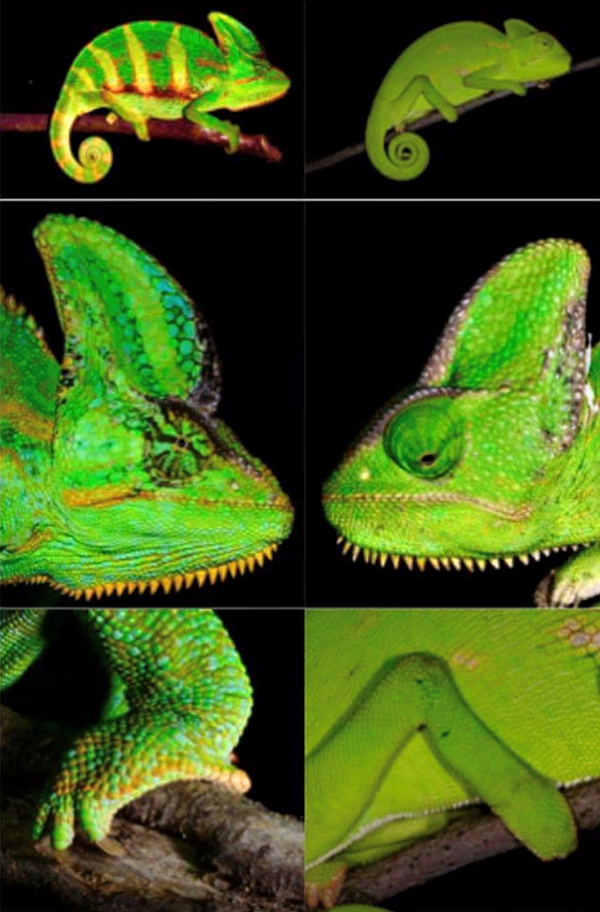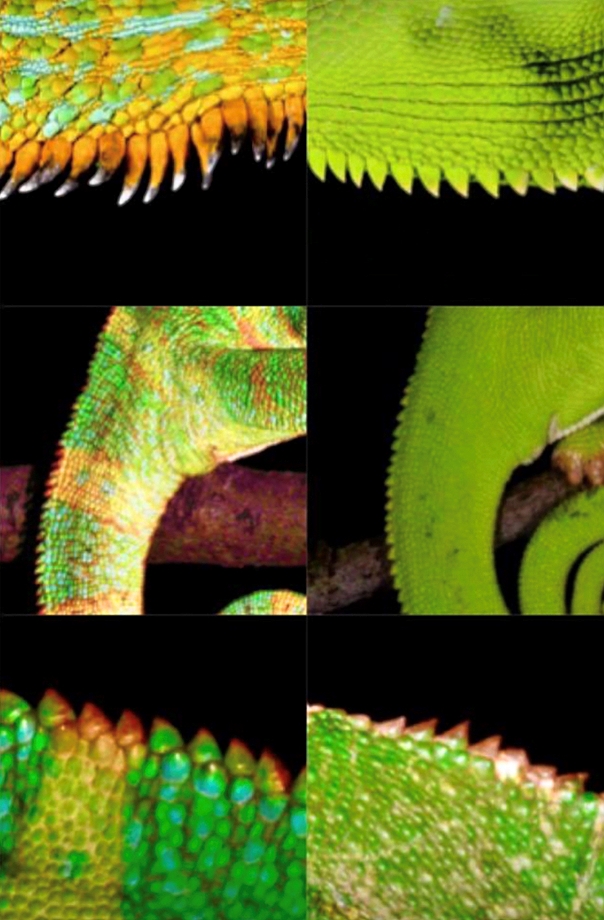Chamaeleo Calyptratus
Yemen Chameleon (Veiled Chameleon)
Author: Petr Nečas
Climate Reference Locality Weather Forecast
Download files
Profile
Origin: Yemen, Saudi Arabia (SW Arabia) (climate reference locality: Ibb, Yemen)
Average total length: Males 17in (45cm), Females 12in (30cm)
Longevity in captivity: Up to 14 years, Average 3-5 years
Longevity in the wild: Up to 1 year
Temperature at daytime: Low 70s F (21-23°C)
Temperature basking spot: Low 80s F (26-28°C)
Temperature at night: Low 70s F max, ideal 50-60s F (20-23°C max, ideally under 18°C)
Humidity at daytime: Below 40%
Humidity at night: 100%, fog
Food: Insects only, No vegetables, No fruits
Indoor Housing
Size: The bigger, the better! Minimum 36x18x36in (90x45x90cm)
Cage Type: Full mesh or hybrid
Light: UVB source (inside or outside), Daylight source (Window or LED) (inside or outside)
Hydration: Fogger at night, hand misting morning and evening
Ventilation: Full mesh, small fans when using a hybrid, cage and/or air is stagnant
Interior: Live plants (no fake), natural branches (no fake vines, no ropes, no bleached wood), no substrate
Care
Sex Determination
In the Yemen chameleons, the sexes differ in many features from each other. They show the s.c. Primary sexual dimorphism, which is expressed through the presence of sexual glands (testes with ductus deferens in males and ovaries with oviducts in females) and copulatory organs (hemipenes in males, hemiclitoris in females).
The problem for sexing animals is, that some of these organs (first group) are situated in the body cavity and some (the second group) in special pockets at the base if the tail, none of them are invisible from outside. There is a technique how to evert the hemipenis, but in young animals and in animals which are dehydrated, old or out of breeding season, it does not work reliably, plus, it might be painful for the animal and is definitely rather stressful, especially if done by an inexperienced owner, therefore not recommended.
Fortunately, there are several Secondary sexual characteristics, which allow us to define the sex rather reliably, especially in adult animals:
SIZE
The males are much bigger than the females, they can reach up to 30in / 19in resp., usually stay much smaller
BODY PROPORTIONS
The females are built more slender with smaller heads
TAIL BASE
Due to the presence of male copulatory organs, hemipenes, the tail base behind cloacal is thicker/swollen in males
TARSAL SPUR
Males have a prominent knob-like protuberance on the heels, while female lack them. This characteristic is is well visible from hatchlings already. Through inbreeding and improper incubation temperatures and regime, however, we can see more and more females with differently developed spurs as well as males with small or lacking spurs.
CASQUE
The casque in males is much higher than in females. Through mistakes in incubation and after sterilization, some females can grow very high casques and resemble a fully developed casque of males.
DORSAL CREST
The conical scales on the dorsal crest are relatively much bigger in males.
GULAR CREST
The conical scales on the gular crest are relatively much bigger in males, plus they are usually orange in males and white in females
COLORATION
The general pattern is in both sexes same, however due the ability to change the color, some skin areas melt in color with each other. The diagnostic features are: orange spots on the flanks possess only females while bright yellow transversal bands on the flanks are confined to males only.
For reliable sex determination, all aspects need to be taken in consideration. In doubt, ask experienced colleagues in for assistance.
Other species of chameleons possess same primary but partly or fully different secondary sexual characteristics...
TABLES
The left column relates always to male, the right to females
They show the differences (top down) in:
WHY THERE IS SO MUCH CONFUSION IN DEFINING THE RIGHT CLIMATIC CONDITIONS FOR THE VEILED CHAMELEONS?
The recommendation of climatic factors necessary for captive management of the Veileds differ dramatically. From high temperatures to low from dry-nomisting recommendations to misting intensely several times a day.
All recommendations are based on experience and survival of the animals. All are valid and all are wrong same time. We are lucky that the Veiled is so much ecologically adaptable, that they can survive very different care and conditions...
Confusion? Yes!
So, what is correct if everything and nothing?!
The only enlightening comes from understanding the climate of Yemen.
Veileds are born at the beginning of the rain period (March) they grow fast and reproduce within 5-6 months (till August) then the dry season starts and within this, almost all adults die...
So, for adulthood of the Veiled, the dry desert-like climate is typical and it is actually rather cold with night drops falling down to the 40s and daytime temperature staying within 70s max. During the dry season almost all Veileds die in the wild.
In the captivity, at least in layman pet-ownership style of captive management, no one cares for simulating the rainy and dry season but wants to have a universal mode kept all the time to be considered "optimal".
So, we decide either to keep them like they would live as adults in the wild or we pretend they would live further and keep them in permanent rainy summer.
So, there are technically two extreme options:
DRY SEASON:
This means no misting required if we provide enough water to drink. And we should keep the temps down and feed very scarcely, even up to 3-4 feeders per week only.
Benefit: they slow down their metabolism, do not move too much and stay alive very long, with almost no problems with skin, eyes, respiration. Females either stop laying eggs, lay smaller clutches or do it in bigger intervals
Risk level: LOW
Or
RAINY SEASON:
We keep the temperatures high as in summer and mist them several times a day.
Benefit: none
Risk level: high
Because of the overwatering, often skin and respiratory diseases and eye infections happen. The faster metabolism supports MBD to appear if mistakes in husbandry happen, increased food intake easily leads to obesity and subsequent failure of inner organs, problems to lay eggs etc. Females lay eggs several times per season, regardless fertile or infertile.
What is correct?
Neither of those and both of those.
My personal recommendation is:
OPTIMAL CHOICE: simulate the seasons and make difference between the rainy and dry periods. The reason why they almost all die is less climate, more food non-availability and predation.
GOOD CHOICE: Simulate dry season permanently
BAD CHOICE: Simulate rainy season permanently
Important note:
All above is for ADULT VEILEDS
JUVENILES grow up in the rainy season, therefore rainy season simulation is required
This is also why we have so many problems if people buy their first chameleon in pet stores as a juvenile!
Either it will not grow properly if we keep cage condition like for an adult or we grow them properly but continue with simulation permanent rainy summer and get all the negative consequences discussed above.
To explain this a pet owner with first chameleon experience and require to get actually two types of the cages and equipment is too much asked for.
Therefore, the BEST solution is: buy an almost fully grown baby from a reputable breeder and simulate a mild permanent dry season further on.
Egg Incubation In Yemen Chameleons In The Wild
In the captivity, Yemen Chameleon eggs are incubated in many ways, they are considered hardy and many ways work in fact...
But...
What is actually the natural way how they are incubated in the wild?
The Yemen Chameleons lay their eggs approx. 12-15cm deep only.
The egg deposition sites are always in shade under trees and their roots.
They lay them in August.
The temperatures of the soil I have measured in that depths were at daytime around 25, at nighttime below 20'C.
During the following months, the temperature drops significantly, so that in December, the soil temps fluctuate between 10-17 and this remains like this till end of January. Then, the temperatures raise slowly to reach a level of 23 daytime to 19 at the night and then a miracle happens:
The rain start to come and the temperature raises rather abruptly to upto 26-27 at daytime and drop to 22 only at night.
When this happens, within about two weeks, they hatch...
What you see from what I wrote, the temperatures are surprisingly low, correct? Well and they need 8months to go...
In captivity, we often peed it up, put them often in constant high temps and get offsprings...
Another issue is: we dig them out, separate them and keep them on a surface instead let them lay digged in the soil in a group...
Be brave and patient, keep them together and cold and you will see the difference in vitality of the young...
YEMEN CHAMELEON , not Veiled Chameleon
The trivial name of this chameleon species is rather confusing and I personally really do not like it.
The specific epithet "calyptratus" is not from Latin but from Greek and was only latinized.
It means "hooded, covered under a hood".
As it has nothing like a Veil, I would really prefer to call it in English same as in all the other languages...
The YEMEN CHAMELEON
There is no right and wrong, as the trivial taxonomy does not have any rules.
So, anyone can use whatever name he wants.
What is the most benefit of the name Yemen Chameleon, it says where the chameleon is from!
In that regard, there's a fighting chance to get the parameters correct for captive keeping.
Let us use the name
The YEMEN CHAMELEON
From now on...



